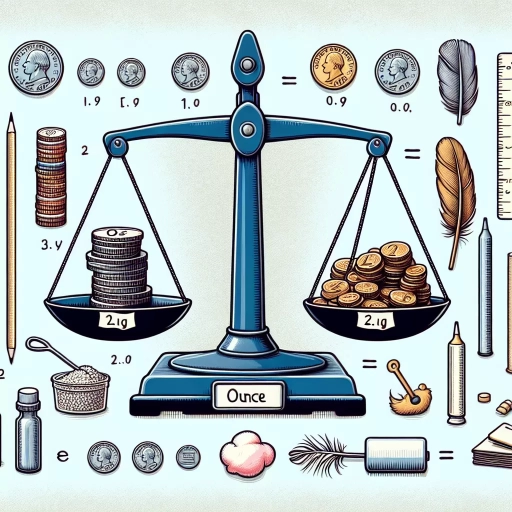How Much Is An Ounce

Understanding Ounces and their Applications
The Definition of an Ounce
An ounce is a unit of weight generally used in the United States. It originates from the old British system of weights, known as the Imperial System. The abbreviation of ounce is 'oz' and an ounce is approximately equivalent to 28.3495 grams in the International System of Units (SI). This distinction is paramount because, even though the term ounce is used internationally, it holds different values, which could lead to confusion if not clarified. Therefore, defining the exact value of an ounce in your local context can influence the answer to the question "How much is an ounce?" comprehensively.
Use of Ounces
While the United States resort to ounces quite regularly, several other regions employ it only for specific purposes. In countries such as the United Kingdom, Canada, and Australia, ounces are largely used when referencing the weight of cooking ingredients or precious metals. Understanding the context in which the ounce is applied is, thus, crucial in comprehending the quantitative value it represents. It could represent food ingredients in a recipe or the weight of precious commodities like gold, thus mentally dedicating at least two different weights - culinary and commercial - to the term ounce.
Converting Ounces to Other Measurement Units
The conversion of ounces to other units is a straightforward process, and most effective when you remember that in the standard system, there are 16 ounces to a pound. Further, you can convert ounces to grams by multiplying the number of ounces by 28.35. Having a clear understanding of these conversions will frequently come in handy, notably in instances such as understanding food portions, buying in bulk, or even recognizing how much you are paying for a certain weight in precious metals.
Navigating through Weights and Measurements
Fluid Ounces Vs. Weight Ounces
Another pivotal distinction in answering the question, "how much is an ounce?" is discerning between fluid ounces and weight ounces. In the United States, fluid ounces are commonly employed to measure the volume of a liquid. This unit is different from weight ounces and each fluid ounce is approximately equivalent to 29.5735 milliliters. When comparing fluid ounces to weight ounces, it is crucial to consider the substance’s density. For instance, water’s weight and volume correspond closely since one fluid ounce of water weighs almost one ounce. However, this is not the case for all substances- hence the critical need for distinction.
Value of an Ounce in Precious Metals
The value of an ounce dramatically escalates when applied to precious metals such as gold, silver, or platinum. As a standard practice worldwide, these commodities are weighed in troy ounces, which is slightly more than the standard ounce, at 31.1035 grams. When asked "how much is an ounce?" in this context, one must consider the present market value of the metal in question. Hence, the quantitative as well as the financial value of an ounce is discussed in precious metal trading.
The Importance of Precision in Measurements
In scientific, medical, and culinary fields, even slight inaccuracies in understanding ounces can lead to significant errors. Therefore, understanding the precision of measurements is extremely important. Digital scales today read weights with precision up to two decimal places for ounces and arguably serve as the best choice when exact measurements are required. Such precision is crucial when handling high-value assets like precious metals or when managing delicate processes such as food or medicine preparation.
Demystifying the Question "How much is an ounce?"
Food and Nutritional Information
How much an ounce represents in terms of food varies significantly based on the type and compaction of the food. For liquids or finely ground solids like flour or sugar, an ounce by volume holds almost the same weight. But for more granulated solids or thinly sliced substances like shredded cheese or sliced fruit, the volume-to-weight ratio can fluctuate. This differentiation is noteworthy for those who are required to or choose to track their food intake meticulously. Thus, an understanding of the food's density becomes essential in translating nutrition facts or meal plans that cite ounces into a comprehensible quantity.
The Impact on Pricing
When pricing products, the value of an ounce can drastically affect the total cost. From bulk shopping to purchasing fine jewelry or precious metals, per ounce pricing is a standard practice. For this, understanding the value of an ounce provides insights into whether you're getting a good deal or not. It can also aid in comparing prices – for instance, whether buying smaller amounts frequently is more economical than buying a larger quantity once. Integrating the concept of ounces into your shopping methods can thus undoubtedly positively affect your financial management.
Conclusion
Conclusively, answering the question "How much is an ounce?" is more complex than it seems at first glance and heavily depends on the context. Whether it is the weight of ingredients in a recipe, the volume of liquid in a bottle, the weight of precious commodities, or the amount of food for dietary plans – knowledge about ounces holds more significance than perceived. Therefore, understanding ounces in all its variety and profundity is necessary in navigating day-to-day tasks, professions, and even hobbies. The more closely you look, the more clearly you see – the ounce is indeed mighty!